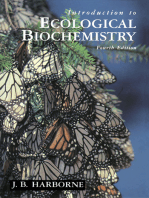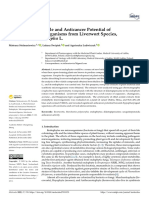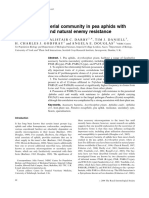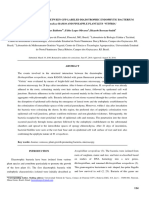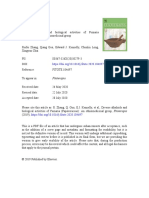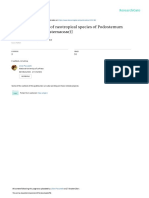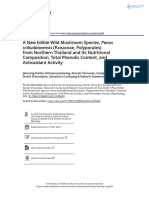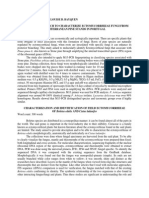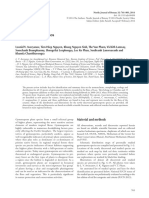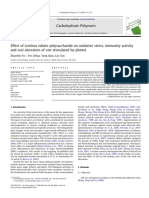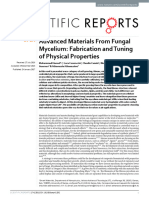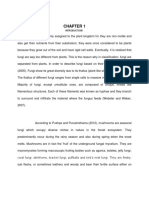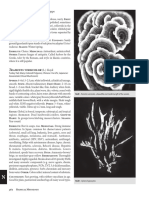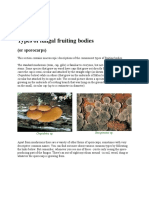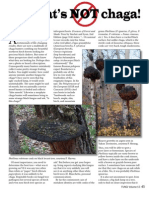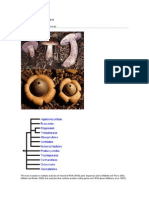Professional Documents
Culture Documents
Zmit R Ovich 2016
Uploaded by
Pauly Campos OyarzúnOriginal Title
Copyright
Available Formats
Share this document
Did you find this document useful?
Is this content inappropriate?
Report this DocumentCopyright:
Available Formats
Zmit R Ovich 2016
Uploaded by
Pauly Campos OyarzúnCopyright:
Available Formats
International Journal of Medicinal Mushrooms, 18(1): 23–38 (2016)
Lentinoid and Polyporoid Fungi, Two Generic
Conglomerates Containing Important Medicinal
Mushrooms in Molecular Perspective
Ivan V. Zmitrovich* & Alexander E. Kovalenko
Laboratory of Systematics and Geography of the Fungi of the Komarov Botanical Institute of the Russian Academy of
Sciences, St. Petersburg, Russia
*Address all correspondence to: Ivan V. Zmitrovich, Laboratory of Systematics and Geography of the Fungi of the Komarov Botanical Institute of
the Russian Academy of Sciences, 2 Professor Popov str., St. Petersburg 197376, Russia; IZmitrovich@binran.ru, iv_zmitrovich@mail.ru
ABSTRACT: Polyporoid and lentinoid fungi contain the important producers of substances having immunomodula-
tory, antitumoral, antiviral, and antihyperlipidemic effects. The discovery of several phylogenetic lines within the
lentinoid-polyporoid continuum will help with target metabolomic analysis of species still not studied in pharmaco-
logical respects. The purpose of the present work was to increase a resolution in the lentinoid-polyporoid phylogenetic
zone by means of selection of both the main representatives of Lentinus-related genera and poorly known/intermedi-
ate taxa such as Lentinus suavissimus, Neofavolus spp., and the resupinate part of Polyporus (genera Perenniporia and
Pachykytospora) in the context of the basic structure of the Polyporales tree. The molecular phylogeny of highlighting
all the polyporoid and lentinoid nodes was reconstructed using nLSU ITS rDNA and TEF datasets. The data obtained
from ITS, TEF, and LSU coincide in support of core Polyporaceae of 10 clades corresponded to the generic level and 7
of these (Cerioporus, Cladomeris, Favolus, Lentinus, Neofavolus, Picipes, and Polyporus s.str.) contain generic units
characterized by polyporoid or lentinoid morphotypes. The other 2 clades containing lentinoid taxa are outside the
core Polyporaceae, namely Panus (Meruliaceae, Polyporales) and Neolentinus (Gloeophyllaceae, Gloeophyllales). A
new genus, Picipes, is described and 25 new combinations are proposed.
KEY WORDS: medicinal mushrooms and fungi, Polyporus s.l., Lentinus s.l., molecular phylogeny, Polyporaceae,
taxonomy
ABBREVIATIONS: BA, Bayesian; ML, maximum likelihood; MP, maximum parsimony
I. INTRODUCTION Friesian establishment of Lentinus was based on his
subtribe Lentoscyphi of the Omphalina tribe of the
Along with the widely distributed term polyporoid Agaricus genus.13 Despite the declaration of affinity
fungi, the term lentinoid fungi has been recently intro- between Lentinus, Favolus, and Polyporus (Favoli
duced into the current literature.1‒4 This applies to very absolute agaricini, Polypori autem favoloidei
genera segregated from Lentinus in Pegler's sense. ab hoc genere neutiquam separari debent14), a for-
Both groups contain the important producers of mal taxonomical position of Polyporus was far from
substances having immunomodulatory, antitumoral, Lentinus in the Friesian system because its large units
antiviral, and antihyperlipidemic effects (Table 1).5‒11 were based on the hymenophore configuration—
Further search for active producers of pharmacologi- poroid or cellar-like in the first and truly lamellate
cally meaningful metabolites within these generic in the second ones.
conglomerates represents a sufficient issue in medici- Torrend15 was the first to adapt the Lloydian genus
nal mushroom science. Lentus for segregation of the lentinoid element of
Beginning with Fries, 12 who described the Polyporus, namely Polyporus brumalis. Kühner16 has
Lentinus genus, the relationships of lentinoid and emphasized the close relationships between Lentinus
polyporoid fungi were obvious for various authors. variabilis (modern name Neolentinus cyathiformis)
1521-9437/16/$35.00 © 2016 Begell House, Inc. www.begellhouse.com 23
24 Zmitrovich & Kovalenko
TABLE 1: Key Representatives of Medicinal Mushrooms within Lentinoid and Polyporoid Fungi
Species Medicinal Properties
Polyporus umbellatus Immune-modulation5,6
Lentinus tuber-regium Immune-modulatory, antiviral7
Lentinus crinitus Anti-inflammatory, direct antitumor8,9
Lentinus strigosus (= Panus lecomtei) Anti-inflammatory, direct antitumor8,9
Lentinus lepideus (= Neolentinus lepideus) Antihyperlipidemic10
Lentinus conchatus (= Panus conchatus) Direct antitumor11
and the Polyporus squamosus group. Singer17‒19 P. brumalis, and P. tricholoma, 29‒31 becomes obvi-
has united Polyporus, Lentinus, and Panus in the ous. Zmitrovich32 has proposed some corresponding
family Polyporaceae, restricted to 3 polyporoid combinations into the genus Lentinus. Subsequent
(Polyporus, Pseudovafolus, and Mycobonia) and molecular tests of large Polyporus,33,34 however, did
4 lamellate (Phyllotopsis, Pleurotus, Panus, and not involve any lentinoid element; even in such a
Lentinus) genera. The genus Lentinus this author has foreshortening, they allow for allocation of an
typified by Lentinus lepideus (the widely accepted independent status of the Neofavolus entity.34 The
typification is connected to L. crinitus), whereas the molecular phylogeny shows the position of the
small-spored velutinate element of this genus he Panus within merulioid lineage, not the polyporoid
left in the Panus. Pouzar20 reported that squamules one.31,35
at the basal portion of the stipe are amyloid both The purpose of the present work is to increase a
in Polyporus species and Lentinus suavissimus. resolution in the lentinoid-polyporoid phylogenetic
Basing on Singer’s classification, Stankovicová21 zone by means of selection both of main section rep-
showed some intermediate morphological phenom- resentatives of Lentinus-related genera and poorly
ena between polyporoid and lentinoid taxa. known/intermediate taxa such as L. suavissimus,
Concerning Lentinus splitting, the first related Neofavolus spp., and the resupinate part of Polyporus
entity was the genus Panus described by Fries22 with (genera Perenniporia and Pachykytospora) in the
type Panus conchatus. A perfectly elaborated dif- context of the basic structure of the Polyporales
ferentiation of Lentinus and Panus was made by tree. Identification of the polyporoid-lentinoid phy-
logenetic zone should help researchers with target
Corner,23 who limited the genus Lentinus to spe-
metabolomics analysis of species still not studied
cies with ligative skeletals, separating species with
in pharmacological respects.
fibroid skeletals into Panus. In parallel, Pegler24
re-established a large Lentinus with 2 subgenera, II. MATERIALS AND METHODS
Lentinus and Panus, based on Cornerian principles.
The further segregation was made by Redhead and A. Taxon Sampling
Ginns,25 who split from Lentinus 2 brown-rot gen-
era, Heliocybe (the type H. sulcata) and Neolentinus A total of 54 specimens of polyporoid and lentinoid
(the type N. kauffmanii). fungi were selected for molecular analysis. We
Furthermore, a sufficient distance between generated a total of 17 ITS, 16 nLSU, and 16 TEF
Lentinus, Panus, and Neolentinus was supported by sequences for this study; 34 additional ITS sequences,
karyological observation26 and molecular studies.3,27 26 additional LSU sequences, and 1 additional TEF
Beginning with Krüger and Gargas, 28 a sequence of other polyporoid/merulioid genera were
congeneric nature of Lentinus s. str. with some repre- retrieved from GenBank based on BLAST results
sentatives of large Polyporus, such as P. arcularius, (http://www.ncbi.nlm.nih.gov/BLAST/). The final
International Journal of Medicinal Mushrooms
Lentinoid and Polyporoid Conglomerates Containing Important Medicinal Mushrooms 25
data set consisted of 51 ITS sequences, 17 TEF Sequencing of this strand was performed with
sequences, and 43 nLSU sequences. an ABI model 3130 Genetic Analyzer (Applied
For all analyses, the sequences of Exidia glan- Biosystems) using the BigDye Terminator
dulosa retrieved from GenBank were chosen as the Cycle Sequencing Ready Reaction Kit (Applied
outgroup based on BLAST homology. Biosystems) with the same primers. The raw data
An overview of all taxa studied is given in Table were processed using Sequencing Analysis 5.3.1
2, which shows the names of species, GenBank (Applied Biosystems).
accession numbers, herbarium numbers, and col-
lection particulars. C. Alignments and Phylogenetic Analysis
B. DNA Extraction, PCR, and Sequencing The sequences were aligned with the web tools
MAFFT (http://align.bmr.kyushu-u.ac.jp/mafft/
DNA was extracted from herbarium material using online/server/) with Q-INS-i strategy and default
2% cetyl trimethylammonium bromide extraction settings for other options. The final alignment was
buffer with the following steps of consecutive corrected manually using MEGA 5.36
addition of the chloroform-isoamyl alcohol mix- Phylogenetic reconstructions were performed
ture (24:1), then isopropyl alcohol and 3 M sodium with maximum parsimony (MP), maximum likeli-
acetate solution for precipitation, 70% ethanol for hood (ML), and Bayesian (BA) analyses.
washing, and finally water for dissolution. The A MP analysis was performed using
NucleoSpin Plant II Kit (Macherey-Nagel) was used PAUP*4.0.b10.37 One-hundred heuristic searches
as an alternative method of DNA extraction. The were conducted by stepwise addition with random
ribosomal ITS1-5.8S-ITS2 region was amplified by sequence addition and a tree bisection-reconnection
PCR with the fungal specific primers ITS1F and branch-swapping algorithm. One tree was held at
ITS4B and the 28S region was amplified by PCR each step during stepwise addition and the num-
with the fungal specific primers LROR and LR7 ber of trees retained was limited to 100. Parsimony
(Vilgalys Laboratory; http://www.biology.duke.edu/ bootstrap analysis was performed with 1000 rep-
fungi/mycolab/primers). The 1000-bp fragment of licates. Gaps were treated as missing characters.
TEF1 was amplified using the primer pair EF1-983F Clades with only a support ≥50% were retained.
and EF1-2212R. ML was run in the RAxML server (version 7.2.8;
For rDNA regions, the following PCR protocol http://phylobench.vital-it.ch/raxml-bb),38 under a
was used: 1) initial denaturation at 95°C for 2 min, GTR model with 100 rapid bootstrap replicates.
2) denaturation at 94°C for 40 s, 3) annealing at Bayesian analysis was performed using MrBayes
50°C for 1 min, 4) extension at 75°C for 2 min, 5) 3.139 for 2 independent runs, each with 10,000,000
repeat for 35 cycles starting at step 2, and 6) leave generations with sampling every 100 generations,
at 75 °C for 10 min. For TEF1, the PCR protocol with a GTR model and 4 chains. Posterior probabil-
included the following steps: 1) initial denaturation ity values ≥0.95 are considered significant.
at 95°C for 2 min, 2) denaturation at 95°C for 40 s,
3) annealing at 60°C for 40 s, 4) extension at 70°C D. Morphological Elaboration
for 2 min, 5) repeat for 9 cycles starting at step 2,
6) denaturation at 95°C for 45 s, 7) annealing at Microscopical study of basidiomata was carried out
50°C for 1.5 min, 8) extension at 70°C for 2 min, 9) as described by Gilbertson and Ryvarden.40 Freehand
repeat for 36 cycles starting at step 6, and 10) leave sections and squash mounts of basidiomata were
at 70°C for 10 min. examined in Melzer’s reagent, 5% KOH, and 2%
The PCR products were purified using the Cotton Blue. Basidiome morphotypes recognized
Fermentas Genomic DNA Purification Kit (Thermo after Zmitrovich et al.41 (see Supplement 1; http://
Scientific). www.researchgate.net/publication/279447216).
Volume 18, Number 1, 2016
26 Zmitrovich & Kovalenko
TABLE 2: Collections Used in This Study of ITS, nLSU, and TEF 1-Alpha Data Sets and Their Herbarium and
GenBank Accession Numbers
Taxon Herbarium Number GenBank Accession Number
ITS nLSU TEF 1-alpha
Buglossoporus pulvinus DQ491419
Chlorophyllum agaricoides AFTOL-ID 440 DQ200928 AY700187
Datronia stereoides Voucher Holonen KC415179 KC415196
Dichomitus squalens LE 258894 KM411455 KM411471 KM411486
Dichomitus squalens Cui9725 JQ780408 JQ780427
Exidia glandulosa TUFC34008 AB871761 AB871742
Junghuhnia rhinocephala JN710562
Lentinus badius GU207275
Lentinus bertieri GU207301
Lentinus bertieri AY615985
Lentinus crinitus LE 114683 KM411462 KR080328 KM411494
Lentinus crinitus AY615980
Lentinus crinitus GU207289
Lentinus cyathiformis EF524038
Lentinus cyathiformis LE 3741 KM411461 KM411477 KM411492
f. montana
Lentinus lepideus LE 3792 KM411454 KM411478 KM411493
f. rufescens
Lentinus strigosus LE 5829 KM411451 KM411468 KM411483
Lentinus tigrinus LE 214778 KM411459 KM411475 KM411490
Lentinus tigrinus MUCL22821 AB478881 AB368072
Lentinus velutinus GQ849478
Neofavolus mikawai TFM:F-27416 AB735962 AB735942
Neolentinus lepideus LE 253834 KM411453 KM411470 KM411485
AB733140 HM536122
Neolentinus lepideus NBRC 30750 AB733140 AB733313
Pachykytospora wasseri LE 814872 (typus) KM411456 KM411472 KM411487
Pachykytospora tuberculosa JX124705
Panus conchatus LE 265028 KM411463 KM434323 KM411496
Panus lecomtei TMIC35103 JQ955726 JQ955733
Panus similis LE 287548 KM411466 KM411482
Panus suavissimus LE 202237 KM411460 KM411476 KM411491
Perenniporia kilemariensis LE 214743 (typus) KM411457 KM411473 KM411488
Perenniporia narymica Dai 7016 JF706331 JF706347
Perenniporia subacida Dai 8224 HQ876605 JF713024
Perenniporia valliculorum LE 222974 (typus) KM411458 KM411474 KM411489
Piptoporus quercinus LE 287547 KM411464 KM411480 KM411497
International Journal of Medicinal Mushrooms
Lentinoid and Polyporoid Conglomerates Containing Important Medicinal Mushrooms 27
Pleurotus giganteus CMU54-1 JQ724360 JQ724361
Polyporus alveolaris TUMH:50003 AB735968 AB735949
Polyporus arcularius Dai 6756 KC572004 KC572043
Polyporus badius LE 236750 KM411465 KM411481 KM411499
Polyporus brumalis PB1 KP283491 KP283520
Polyporus chozeniae LE 22545 KM411479 KM411495
Polyporus grammocephalus WD2379 AB587628 AB587619
Polyporus melanopus MJ132-95 KC572025 KC572066
Polyporus pseudobetulinus TFM:F-27626 AB587645 AB587640
Polyporus squamosus AFTOL-ID 704 DQ267123 AY629320
Polyporus squamosus LE 287549 KM411467
f. rangiferinus
Polyporus subvarius WD2368 AB587643 AB587638
Polyporus tenuiculus KM267725
Polyporus tubaeformis voucher Niemela KC572036 KC572073
Polyporus tuberaster Dai 4662 KC572037 KC572074
Polyporus umbellatus ZL-QH-2 JX110724 JX110762
Polyporus varius Dai 12813 KC572040 KC572077
Serpula lacrymans REG 383 GU187542 GU187596
Steccherinum tenuispinum LE 231603 (typus) KM411452 KM411469 KM411484
Steccherinum tenuispinum JN710599
III. RESULTS AND DISCUSSION The consequences of molecular resolution of
phylogenetic pathways in the polyporoid-lentinoid
A. Ten Clades in the Polyporoid-Lentinoid continuum seem to be sufficient. The LSU data set
Continuum appears the most informative for resolution of clade
interrelationships. The clade Cerioporus seems to
The results of molecular taxonomical analysis of be an ancient lineage in core polyporoid radiation.
the lentinoid-polyporoid taxonomical continuum This unit contains fungi of polyporoid morphotype
are presented in Figs. 1‒3 (in which ITS and com- characterized by more or less inflated axial ele-
bined ITS+TEF+LSU phylogenies are given) and ment of skeleto-binding dendrite. Such inflation
Table 3 (where all of the molecular entities are can be interpreted as a residual phenomenon of
characterized). physalohyphae sclerification in basically a tyromy-
All of the data obtained from ITS, TEF, and cetoid‒scutigeroid morphotype. The basidiospores
LSU coincide in support within core Polyporaceae in all representatives included are characterized by
of 10 clades corresponded to generic levels, and 7 of subfusoid to subnavicular appearance. The tendency
these clades contain a generic units characterized by to trametization is obvious within this line (C. var-
polyporoid or lentinoid morphotypes. The remain- ius, C. stereoides, C. mollis).
ing 2 clades containing lentinoid taxa lie outside The further phylogenetic radiation is based
of core Polyporaceae, namely Panus (Meruliaceae, on Lentinus (including Polyporellus) lineage.
Polyporales) and Neolentinus (Gloeophyllaceae, Their representatives keep an inflation of axial
Gloeophyllales) (Table 3). element of skeleto-binding dendrite, but hyphal
Volume 18, Number 1, 2016
28 Zmitrovich & Kovalenko
FIG. 1: The best tree obtained from the ML analysis of combined LSU data set. Bootstrap values (%) from MP and
posterior probability from BY analyses are shown under and above the branches, respectively.
ramification here is more regular having dicho- represent a result of partial exospore degradation
phytic appearance as a result. The hymenophore of basidiospores of the Perenniporia type.42
configuration in Lentinus representatives var- The crown group is presented by independent
ies from poroid or radially poroid in various lineages Polyporus s. str., Neofavolus, Cladomeris,
representatives of Polyporellus sublineage to true Picipes, and Favolus. It is possible that more ancient
lamellate with lamellae and lamellulae (Lentinus lineage of the crown group is Cladomeris represented
and Tigrini sublineage representatives). Numerous by one sclerotium-forming species of grifoloid
superficial adaptations are characteristic to tropi- morphotype (C. umbellatus). This species is char-
cal taxa (e.g., an upperside pillar development). acterized by predominance of protoplasm-bearing
The main morphogenetic tendency in tropical taxa hyphae with inflated axial segments. The substi-
is the substitution of protoplasma-bearing hyphae tution of protoplasm-bearing hyphae by sclerified
by sclerified dendrites in all tissues of basidiome. dendrites with inflated axial element is characteristic
The basal Polyporellus sublineage can be mor- to Picipes lineage (=Polyporus melanopus group),
phogenetically connected to derivative trametoid uniting fungi of the polyporoid morphotype with
(Dichomitus) and fibroporioid (Pachykytospora, small pores, blackish stipe cuticle, and tendency to
Perenniporia) morphotypes. Dichomitus keeps trametization. Generative hyphae in P. badius are
micromorphological identity with the Lentinus devoid of clamps, whereas all of the other representa-
lineage, whereas the Perenniporia lineage is tives bear the fibulate hyphae. The basidiospores in
characterized by basidiospore wall sclerification. both Cladomeris and Picipes lines are cylindric. The
The verrucose basidiospores of Pachykytospora lineage Polyporus s. str. (P. tuberaster) is connected
International Journal of Medicinal Mushrooms
Lentinoid and Polyporoid Conglomerates Containing Important Medicinal Mushrooms 29
FIG. 2: The best tree obtained from the ML analysis of ITS data set. Bootstrap values (%) from MP and posterior
probability from BY analyses are shown under and above the branches, respectively.
to Cladomeris by other way: this is sclerotium-form- trametization (Favolus) and lentination (Neofavolus
ing polypore with sclerified dichophytic skeletals suavissimus) of Picipes-like morphotypes. Some
and elongated spores due to large subcellular pores. Favolus representatives are devoid of clamps. The
The characters’ patterns of Favolus and Neofavolus basidiospores in Neofavolus and Favolus are cylin-
allow characterize them as certain scraps of lines to dric, like those of Picipes representatives.
Volume 18, Number 1, 2016
30 Zmitrovich & Kovalenko
FIG. 3: The best tree obtained from the ML analysis of combined TEF–ITS–LSU data set. Bootstrap values (%) from
MP and posterior probability from BY analyses are shown under and above the slash, respectively.
The consensus dataset indicates multiple ori- Lentinus s. str. has to include the Polyporus arcu-
gins of polyporoid and lentinoid morphotypes, the larius group. The corresponding combinations were
phylogenetically derivative nature of lentinoid and made by Zmitrovich32; however, the name Lentinus
resupinate poroid morphotypes, as well as the ten- ciliatus (Fr.) Zmitr. would be rejected as invalid and
dency of transformation of skeleto-binding dendrites replaced by the new correct name. Another matter is
into fibrohyphae massifs in long-lived basidiomes. final recognition of heterogeneity of the remaining
The taxonomical consequences of such a res- Polyporus. Until now, the Polyporus conglomerate
olution are also diverse. In particular, the genus has been kept as widely known and corresponding
International Journal of Medicinal Mushrooms
Lentinoid and Polyporoid Conglomerates Containing Important Medicinal Mushrooms 31
TABLE 3: Phylogenetic Overview of the Polyporoid-Lentinoid Continuum
Clade Name Phylogeny Supporting Morphological Characterization
Characteristics
Core polyporoid phylogenetic radiation
Cerioporus* ITS (‒/0.98); LSU (53/‒); Polyporoid to trametoid; dimitic with inflated axial skeletals
combined (94/1) and arboriform branching; basidiospores fusoid, with
navicular tendency, or humpbacked
Cladomeris* Combined (100/1) Polyporoid – grifoloid; subdimitic with inflated axial hyphae
and ±dichophytic branching; basidiospores subcylindric
Dichomitus Combined (100/1) Trametoid to fibroporioid; dimitic with inflated axial skeletals
and dichophytic branching; basidiospores fusoid, smooth,
thin-walled
Favolus* ITS (71/‒); LSU (97/1); Polyporoid – favoloid; dimitic with uninflated axial element
combined (99/1) and arboriform branching; basidiospores with fusoid or
navicular tendency
Lentinus*/** ITS (87/1); LSU (93/1); Lentinoid or polyporoid; dimitic with inflated axial element
combined (95/1) ±dichophytic branching; basidiospores subcylindric
Neofavolus*/** LSU (91/‒); combined (94/1) Polyporoid (favoloid) or lentinoid; dimitic with uninflated axial
element and rare; ±dichophytic branching; basidiospores
subcylindric
Pachykytospora combined (96/0.99) Fibroporioid; dimitic with inflated axial skeletals and arbori-
form branching; basidiospores fusoid-elliptical, with ridged
exosporium
Perenniporia ITS (86/0.98); combined Trametoid to fibroporioid; dimitic with inflated axial skeletals
(99/1) and arboriform branching; basidiospores truncate, smooth,
thick-walled
Picipes* ITS (88/1); LSU (89/0.98); Polyporoid without sclerotium; dimitic or trimitic with
combined (98/1) uninflated axial skeletals and active dichophytic branching;
basidiospores cylindric, <10 μm long
Polyporus s.str.* Combined (100/1) Polyporoid arising from sclerotium; dimitic with uninflated
axial skeletals and moderate dichophytic branching; basidio-
spores fusoid, >10 μm long
Merulioid phylogenetic radiation
Panus** ITS (98/1); LSU (98/1); Lentinoid; dimitic with fibrohyphae (uninflated with collapsed
combined (100/1) appendages); basidia < 30 μm long; basidiospores
subcylindric; white-rot fungi
Gloeophyllales phylogenetic radiation
Neolentinus** ITS (96/1); LSU (93/0.95); Lentinoid; dimitic with fibrohyphae (uninflated with collapsed
combined (98/1) appendages); basidia > 30 μm long; basidiospores with
navicular or fusoid tendency; brown-rot fungi
Bootstrap values (%) from MP and posterior probability from BY analyses are shown below and above the slash, respectively.
*Entity unites species of polyporoid (including favoloid) morphotype.
**Entity unites species of lentinoid morphotype.
*/**Entity unites species both of polyporoid and lentinoid morphotypes.
Volume 18, Number 1, 2016
32 Zmitrovich & Kovalenko
TABLE 4: Diagnostic Key to Genera of Polyporoid and Lentinoid Fungi
I. Sclerohyphae unbranched at the maturity (fibrohyphae) – uninflated with collapsed appendages; their
abundant terminations in the hymenium are recognized as pseudocystidia. Hymenophore lamellate.
A. Basidia <30 μm at maturity. Basidiospores cylindric. Cause a white rot. ... Panus.
B. Basidia >30 μm at maturity. Basidiospores with navicular or fusoid tendency.
Cause brown-rot. ... Neolentinus.
II. Sclerohyphae sympodially branched. Pseudocystidia none. Hymenophore lamellate, cellar, or poroid.
A. Axial element of skeleto-binding dendrite is recognizable owing to its inflation.
1. Hyphal system subdimitic, sclerohyphae absent in hymenophorla trama. Basidiomes of grifoloid
morphotype. Basidiospores subcylindric. ... Cladomeris.
2. Hyphal system dimitic, sclerohyphae present in hymenophoral trama. Basidiomes of polyporoid,
trametoid, or lentinoid morphotypes.
α. Basidiomes of polyporoid or trametoid morphotype. Basidiospores fusoid, with navicular tendency,
or humpbacked. ... Cerioporus.
β. Basidiomes of lentinoid or polyporoid morphotype. Basidiospores subcylindric. ... Lentinus.
B. Axial element of skeleto-binding dendrite uninflated.
1. Sclerohyphae dichophytic. Basidiomes of polyporoid morphotype.
α. Sclerohyphae moderately branched. Basidiospores fusoid, >10 μm long. Basidiomata arising from
sclerotium. ... Polyporus.
β. Sclerohyphae strongly branched. Basidiospores cylindric, <10 μm long. Sclerotium absent. ...
Picipes.
2. Sclerohyphae arboriform. Basidiomes of polyporoid, favoloid, or lentinoid morphotype.
α. Sclerohyphae regularly branched. Basidiospores with fusoid or navicular tendency. Basidiomes of
polyporoid or favoloid morphotype. ... Favolus.
β. Sclerohyphae rarely branched. Basidiospores subcylindric. Basidiomes of favoloid or lentinoid
morphotype. ... Neofavolus.
to the everyday patrimonial generic concept,43‒45 B. Diagnostic Key to Genera of
although the micromorphological diversity within Polyporoid and Lentinoid Fungi
this genus was discussed by some authors.46‒50 The
discovery of an independent lineage, which includes A diagnostic key to genera of polyporoid and lenti-
the Polyporus type (Polyporus tuberaster), raised noid fungi is presented in Table 4.
a problem of restoration of old and establishing of
new names for remaining lineages: Cerioporus (type C. Taxonomical Catalogue of Polyporoid
P. squamosus), Cladomeris (type P. umbellatus), and Lentinoid Fungi
Favolus (type P. brasiliensis), and Neofavolus (type
P. alveolaris). The last lineage also includes lentinoid The catalogue presented in Table 5 reflects the view
elements such as L. suavissimus. Such rearrangement of the Polyporus s.l.‒Lentinus s.l. conglomerate on
successfully solves a problem of Datronia. This tram- a molecular perspective. Therefore, some nomen-
etoid unit joins in polyporoid Cerioporus. clatural innovations are given here. An enlarged
The revealing of several phylogenetic lines version of the taxonomical catalogue of polyporoid
within the lentinoid-polyporoid continuum undoubt- and lentinoid fungi, which includes a synonymy of
edly will help with target metabolomic analysis of all of the taxa, is presented in Supplement 2 (http://
species still not studied in pharmacological respects. www.researchgate.net/publication/279447065).
International Journal of Medicinal Mushrooms
Lentinoid and Polyporoid Conglomerates Containing Important Medicinal Mushrooms 33
TABLE 5: Taxonomical Catalogue of Polyporoid and Lentinoid Fungi
POLYPORALES
POLYPORACEAE
CERIOPORUS Quél., Ench. Fung.: 167, 1886.
Type: Boletus squamosus Huds., 1778.
Cerioporus admirabilis (Peck) Zmitr. et Kovalenko comb. nov. (MB 812034). – Bas.: Polyporus admirabilis
Peck, Bull. Torrey Bot. Cl. 26: 69, 1899.
Cerioporus choseniae (Vassilkov) Zmitr. et Kovalenko comb. nov. (MB 812035). – Bas.: Piptoporus choseniae
Vassilkov, Nov. Sist. Nizsch. Rast. 4: 244, 1967 [ut ‘chozeniae’];
Cerioporus corylinus (Mauri) Zmitr. et
Kovalenko comb. nov. (MB 812036). – Bas.: Polyporus corylinus Mauri, Giorn. Arc. Roma 54: 3, 1818.
Cerioporus hygrocybe (M. Pieri et B. Rivoire) Zmitr. et Kovalenko comb. nov. (MB 812269). – Bas.:
Polyporus hygrocybe M. Pieri et B. Rivoire, Bull. Soc. Mycol. France 121: 10, 2005.
Cerioporus leptocephalus (Jacq.) Zmitr. et Kovalenko comb. nov. (MB 812037). – Bas.: Boletus leptocephalus
Jacq., Miscell. austriac. 1: 142, 1778 [Polyporus leptocephalus Jacq.: Fr., 1821].
Cerioporus meridionalis (A. David) Zmitr. et Kovalenko comb. nov. (MB 812038). – Bas.: Leucoporus
meridionalis A. David, Bull. Soc. Mycol. France 88: 301, 1972.
Cerioporus mollis (Sommerf.) Zmitr. et Kovalenko comb. nov. (MB 812039). – Bas.: Daedalea mollis
Sommerf., Suppl. Fl. Lapp.: 271, 1826.
Cerioporus rhizophilus (Pat.) Zmitr. et Kovalenko comb. nov. (MB 812040). – Bas.: Polyporus rhizophilus
Pat., J. Bot. 8: 219, 1894.
Cerioporus squamosus (Huds.) Quél., Enchir. Fung.: 166, 1886.
Cerioporus squamosus (Huds.) Fr. f. rangiferina (Bolton) Zmitr. et Kovalenko comb. et stat. nov. (MB
812607). – Bas.: Boletus rangiferinus Bolton, Hist. fung. Halifax 3: 138, 1790.
Cerioporus stereoides (Fr.) Zmitr. et Kovalenko comb. nov. (MB 812041). – Bas.: Polyporus stereoides Fr.,
Observ. mycol. 2: 258, 1818.
Cerioporus varius (Pers.) Zmitr. et Kovalenko comb. nov. (MB 812042). – Bas.: Boletus varius Pers.,
Observ. mycol. 1: 85, 1796 [Polyporus varius Pers.: Fr., 1821].
Cerioporus vassilievae (Thorn) Zmitr. et Kovalenko comb. nov. (MB 812047). – Bas.: Polyporus vassilievae
Thorn, Karstenia 40(1−2): 185, 2000.
Provisional position: Datronia scutellata (Schwein.) Gilb. et Ryvarden, Mycotaxon 22: 364, 1985; D. decipiens
(Bres.) Ryvarden, Mycotaxon 33: 308, 1988.
CLADOMERIS Quél., Enchir. fung.: 167, 1886.
Type: Boletus umbellatus Pers., 1801.
Cladomeris umbellata (Pers.) Quél., Enchir. fung.: 167, 1886.
FAVOLUS Fr., Elench. 1: 44, 1828.
Type: Merulius daedaleus Link, 1789.
Favolus albostipes (Ryvarden et Iturr.) Zmitr. et Kovalenko comb. nov. (MB 812043). – Bas.: Polyporus
albostipes Ryvarden et Iturr., Mycologia 95: 1071, 2003.
Favolus acervatus (Lloyd) Sotome et T. Hatt., Fungal Div. 58: 254, 2013.
Favolus biskeletalis (Corner) Zmitr. et Kovalenko comb. nov. (MB 812044). – Bas.: Polyporus biskeletalis
Corner, Beih. Nova Hedwigia 78: 57, 1984.
F. brasiliensis (Fr.) Fr., Linnaea 5: 511, 1830 [Daedalea brasiliensis Fr., 1821].
Favolus elongoporus (Drechsler-Santos et Ryvarden) Zmitr. et Kovalenko comb. nov. (MB 812045). – Bas.:
Polyporus elongoporus Drechsler-Santos et Ryvarden, Syn. Fung. 25: 39, 2008.
Volume 18, Number 1, 2016
34 Zmitrovich & Kovalenko
TABLE 5: (Continued)
F. emerici (Berk. ex Cooke) Imazeki, Bull. Tokyo Sci. Mus. 6: 95, 1943.
Favolus ianthinus (Gibertoni et Ryvarden) Zmitr. et Kovalenko comb. nov. (MB 812046). – Bas.:
Polyporus ianthinus Gibertoni et Ryvarden in Gibertoni, Ryvarden et Cavalcanti, Syn. Fung. 18: 53, 2004.
F. philippinensis Berk., London J. Bot. 1: 148, 1842.
F. pseudobetulinus (Murashk. ex Pilát) Sotome et T. Hatt., Fungal Div. 58: 260, 2013.
F. roseus Lloyd, Mycol. Writ. 7: 1157, 1922.
F. spathulatus (Jungh.) Lév., Ann. Sci. Nat. Bot. (ser. 3) 2: 203, 1844.
Favolus udus (Jungh.) Zmitr. et Kovalenko comb. nov. (MB 812076). – Bas.: Polyporus udus Jungh., Tijdskr.
Nat. Gesch. Physiol. 7: 289, 1940.
LENTINUS Fr., Syst. Orbis Veg. 1: 77, 1825.
Type: Agaricus crinitus L., 1763.
Lentinus alpacus Senthil. et S. K. Singh in Senthilarasu, Sharma et Singh, Mycotaxon 121: 70, 2013.
Lentinus anastomosans Rick, Lilloa 2: 310, 1938.
Lentinus anthocephalus (Lév.) Pegler, Bull. Jard. Bot. Natn. Belg. 41: 280, 1971.
Lentinus araucariae Har. et Pat., J. Bot. 17: 11, 1903.
Lentinus arcularius (Batsch) Zmitr., Int. J. Medicinal Mushrooms 12(1): 88, 2010.
Lentinus atrobrunneus Pegler, Bull. Jard. Bot. Natn. Belg. 41: 275, 1971.
Lentinus badius (Berk.) Berk., London J. Bot. 6: 491, 1847.
Lentinus baguirmiensis Pat. et Har., Bull. Soc. mycol. France 24: 14, 1908.
Lentinus bambusinus T. K. A. Kumar et Manim., Mycotaxon 92: 119, 2005.
Lentinus bertieri (Fr.) Fr., Syst. Orbis Veg. 1: 77, 1825.
Lentinus brumalis (Pers.) Zmitr., Int. J. Medicinal Mushrooms 12(1): 88, 2010.
Lentinus brunneofloccosus Pegler, Bull. Jard. Bot. Natnl Belg. 41: 278, 1971.
Lentinus calyx (Speg.) Pegler, Kew Bull. Add. Ser. 9: 32, 1983.
Lentinus cladopus Lév., Ann. Sci. Nat. Bot. (Ser. 3) 2: 174, 1844.
Lentinus concavus (Berk.) Henn. in Engler et Prantl, Nat. Pflfam. 1: 224, 1900.
Lentinus concentricus Karun., K. D. Hyde et Zhu L. Yang in Karun., Yang, Zhao, Vellinga, Bahkali,
Chukeatirote et K. D. Hyde, Mycol. Progr. 10(4): 395, 2011.
Lentinus concinnus Pat., Bull. Soc. Mycol. France 8: 47, 1892.
Lentinus connatus Berk., London J. Bot. 1(3): 145, 1842.
Lentinus crinitus (L.) Fr., Syst. Orbis veg. 1: 77, 1851.
Lentinus dicholamellatus Manim. in Manim., Divya, Kumar, Vrinda et Pradeep, Mycotaxon 90(2): 312, 2004.
Lentinus flexipes (Fr.) Zmitr. et Kovalenko comb. nov. (MB 812268). – Bas.: Polyporus flexipes Fr., Linnaea 5:
515, 1830.
Lentinus glabratus Mont. in La Sagra, Cuba Pl. Cell.: 424, 1842.
Lentinus longiporus (Audet, Boulet et Sirard) Zmitr. et Kovalenko comb. nov. (MB 812110). – Bas.: Polyporus
longiporus Audet, Boulet et Sirard in Boulet, Les Champignons des Arbres de l’Est de l’Amérique du Nord: 530,
2003.
Lentinus megacystidiatus Karun., K. D. Hyde et Zhu L. Yang in Karun., Yang, Zhao, Vellinga, Bahkali,
Chukeatirote et K. D. Hyde, Mycol. Progr. 10(4): 393, 2011.
International Journal of Medicinal Mushrooms
Lentinoid and Polyporoid Conglomerates Containing Important Medicinal Mushrooms 35
Lentinus nigroosseus Pilát, Ann. Mycol. 34: 122, 1936.
Lentinus polychrous Lév., Ann. Sci. Nat. Bot. (Ser. 3) 2: 175, 1844.
Lentinus retinervis Pegler, Kew. Bull. Add. Ser. 9: 30, pl. 1b, 1983.
Lentinus roseus Karun., K. D. Hyde et Zhu L. Yang in Karun., Yang, Zhao, Vellinga, Bahkali, Chukeatirote
et K. D. Hyde, Mycol. Progr. 10(4): 392, 2011.
Lentinus sajor-caju (Fr.) Fr., Epicr.: 393, 1838.
Lentinus sclerogenus Sacc., Nuov. Giorn. Bot. Ital. 23: 230, 1916.
Lentinus squarrosulus Mont., Ann. Sci. Nat. Bot. (ser. 2) 18: 21, 1842.
Lentinus striatulus Lév., Ann. Sci. Nat. Bot. (Ser. 3) 5: 120, 1846.
Lentinus stupeus Klotzsch, Linnaea 8: 480, 1833 [ut ‘stupens’].
Lentinus substrictus (Bolton) Zmitr. et Kovalenko comb. nov. (MB 812111). – Bas.: Boletus substrictus
Bolton, Hist. fung. Halifax, App.: 170, 1792.
Lentinus swartzii Berk., Hook. London J. Bot. 2: 632, 1843.
Lentinus tigrinus (Bull.) Fr., Syst. Orbis Veg.: 78, 1825.
Lentinus tuber-regium (Fr.) Fr., Syn. generis Lentinus: 3, 1836.
Lentinus umbrinus H. W. Reichardt, Verh. Zool.-Bot. Ges. Wien 16: 375, 1866.
Lentinus villosus Klotzsch, Linnaea 8: 479, 1833.
Lentinus vossii (Kalchbr.) Zmitr. et Kovalenko comb. nov. (MB 812112). – Bas.: Polyporus vossii Kalchbr.,
Verh. zool.-bot. Ges. Wien 29: 689, 1879.
Lentinus zeyheri Berk., Hook. London J. Bot. 2: 514, 1843.
NEOFAVOLUS Sotome et T. Hatt., Fungal Div. 58(1): 249, 2013.
Type: Merulius alveolaris DC., 1815.
Neofavolus alveolaris (DC.) Sotome et T. Hatt., Fungal Div. 58(1): 250, 2013.
N. cremeoalbidus Sotome et T. Hatt., Fungal Div. 58(1): 250, 2013.
N. mikawai (Lloyd) Sotome et T. Hatt., Fungal Div. 58(1): 251, 2013.
Neofavolus suavissimus (Fr.) Zmitr. et Kovalenko comb. nov. (MB 812026). – Bas.: Lentinus suavissimus Fr.,
Meth. Grund. Mod. Pflanzensoziol.: 13, 1836.
Provisional position: Lentinus lamelliporus Har. et Pat., Bull. Mus. Nat. Hist. 8: 131, 1902.
PICIPES Zmitr. et Kovalenko gen. nov. (MB 812027)
= Melanopus Pat., 1887 in Donk’s (1960) typification. Nomen ambiguum.
Basidiomata annual, stipitate, of polyporoid morphotype. Pilei infundibiliform, covered with hard cuticle, without
scales, smoke gray to castaneous or deeply brown. Stipe covered with brownish to black cuticle. Pores small
(more than 5 per mm). Hyphal system dimitic with uninflated both corioiloid and fibrous skeletals; the last ones
are subsolid. Clamps present or absent. Basidiospores cylindric, smooth, hyaline. On wood of frondose and
coniferous trees causing a white rot.
Type: Boletus badius Pers., 1801.
Etymology: piceus – covered by tar, pes – stipe. This term refers to Polyporus picipes Fr. and substitutes the
name Melanopus Pat. nom. ambig. based on Polyporus melanopus Sw.: Fr.
A numerous branched skeletals with uninflated axial elements, numerous subsolid fibrohyphae in combination
with small pores and dark-colored stipe cuticle are characteristic for the genus.
Picipes badius (Pers.) Zmitr. et Kovalenko comb. nov. (MB812028). – Bas.: Boletus badius Pers., Syn. Meth.
Fung. 2: 253, 1801.
Volume 18, Number 1, 2016
36 Zmitrovich & Kovalenko
TABLE 5: (Continued)
Picipes melanopus (Pers.) Zmitr. et Kovalenko comb. nov. (MB812029). – Bas.: Boletus melanopus Pers.,
Tent. Disp. Meth. Fung.: 70, 1797 [Polyporus melanopus Pers.: Fr., 1821].
Picipes tubaeformis (P. Karst.) Zmitr. et Kovalenko comb. nov. (MB812030). – Bas.: Polyporellus varius subsp.
tubaeformis P. Karst., Meddn Soc. Fauna Fl. Fennica 9: 69, 1882.
POLYPORUS [Mich.] Fr., Syst. Mycol. 1: 341, 1821.
Type: Polyporus tuberaster Jacq. ex Pers. per Fr., 1821.
Polyporus tuberaster (Jacq. ex Pers.) Fr., Syst. Mycol. 1: 347, 1821.
MERULIACEAE
PANUS Fr., Syst. Mycol. 1: 396, 1821.
Type: Agaricus conchatus Bull., 1787.
Panus ciliatus (Lév.) T. W. May et A. E. Wood, Mycotaxon 54: 148, 1995.
Panus conchatus (Bull.: Fr.) Fr., Epicr.: 397, 1838.
Panus fasciatus (Berk.) Singer, Agaricales mod. Tax. 2nd ed.: 172, 1962.
Panus hookerianus (Berk.) T. W. May et A. E. Wood, Mycotaxon 54: 148, 1995.
Panus lecomtei (Fr.) Corner, Beih. Nova Hedw. 69: 90, 1981.
Panus similis (Berk. et Broome) T. W. May et A. E. Wood, Mycotaxon 54: 148, 1995.
Panus strigellus (Berk.) Chardon et Toro, Monogr. Univ. Porto Rico Ser. B 2: 315, 1934.
Panus tephroleucus (Mont.) T. W. May et A. E. Wood, Mycotaxon 54: 148, 1995.
Panus velutinus (Fr.) Overh., J. Dept Agric. Porto Rico 14: 353, 1930 non Fr., 1838.
Provisional position: Lentinus martianoffianus Kalchbr. in Thüm., Bull. Mosk. Obshch. Ispyt. Prir. 52: 144, 1877;
L. hirtiformis Murrill, N. Am. Fl. 9: 293, 1915; L. courtetianus Har. et Pat., Bull. Mus. Hist. Nat. Paris 15: 88,
1909.
GLOEOPHYLLALES
GLOEOPHYLLACEAE
NEOLENTINUS Redhead et Ginns, Trans. Mycol. Soc. Japan 26(3): 357, 1985.
Type: Lentinus kaufmannii A. H. Sm., 1946.
Neolentinus adhaerens (Alb. et Schwein.) Redhead et Ginns, Trans. Mycol. Soc. Japan 26(3): 357, 1985.
Neolentinus cirrhosus (Fr.) Redhead et Ginns, Trans. Mycol. Soc. Japan 26(3): 357, 1985.
Neolentinus cyathiformis (Schaeff.) Della Maggiora et Trassinelli, Index Fungorum 171: 1, 2014.
Neolentinus dactyloides (Cleland) Redhead et Ginns, Trans. Mycol. Soc. Japan 26(3): 357, 1985.
Neolentinus kauffmanii (A. H. Sm.) Redhead et Ginns, Trans. Mycol. Soc. Japan 26(3): 357, 1985.
Neolentinus lepideus (Fr.) Redhead et Ginns, Trans. Mycol. Soc. Japan 26(3): 357, 1985.
Neolentinus lepideus f. rufescens (A. N. Petrov) Zmitr. et Kovalenko comb. nov. (MB 812274). – Bas.:
Lentinus lepideus f. rufescens A. N. Petrov, Mikol. Fitopatol. 21(1): 38, 1987.
Neolentinus pallidus (Berk. et M. A. Curtis) Redhead et Ginns, Trans. Mycol. Soc. Japan 26(3): 357, 1985.
Neolentinus papuanus (Hongo) Redhead et Ginns, Trans. Mycol. Soc. Japan 26(3): 357, 1985.
Neolentinus ponderosus (O. K. Mill.) Redhead et Ginns, Trans. Mycol. Soc. Japan 26(3): 357, 1985.
Neolentinus sulcatus (Berk.) F. Rune, Mycol. Res. 98(5): 543, 1994.
International Journal of Medicinal Mushrooms
Lentinoid and Polyporoid Conglomerates Containing Important Medicinal Mushrooms 37
ACKNOWLEDGMENTS 12. Fries EM. Systema orbis vegetabilis. Pars I. Plantae
homonemae. Lund (Sweden): Typographia Academica,
1825, 374 pp.
The authors thank Dr. Vera V. Malysheva for valu-
13. Fries EM. Systema mycologicum, sistens fungorum
able help in the molecular studies. This work was ordines, genera et species, huc usque cognitas, quas ad
carried out in the canvas of the state task “South normam methodi naturalis determinavit, disposuii atque
Vietnamese mycobiota” (N 01201255603). The descripsit. 1. Gryphiswald, 1821, 520 pp.
molecular part of this work is supported by RFFI 14. Fries EM. Elenchus fungorum, sistens commentarium in
(N 13-04-00838). Systema mycologicum. I. Gryphiswald, 1828, 238 pp.
15. Torrend C. Les Polyporaceés du Brésil: Polyporaceés stipi-
tées. Brotéria. 1920;18:121–42.
REFERENCES 16. Kühner R. Notes sur la Lentinus variabilis Schulz. Bull
Soc Mycol France. 1928;44:331–5.
1. Thorn RG, Moncalvo JM, Reddy CA, Vilgalys R. 17. Singer R. The Agaricales (mushrooms) in modern tax-
Phylogenetic analyses and the distribution of nema- onomy. Lilloa. 1951;22:1–832.
tophagy support a monophyletic Pleurotaceae within 18. Singer R. The Agaricales in modern taxonomy, 2nd ed.
the polyphyletic pleurotoid-lentinoid fungi. Mycologia. Weinheim, 1962, 915 pp.
2000;92:241–52. 19. Singer R. The Agaricales in modern taxonomy, 3rd ed.
2. Douanla-Meli C. Fungi of Cameroon. Bibltheca Mycol. Vaduz: J. Cramer, 1975, 912 pp.
2007;202:1–410. 20. Pouzar Z. Amyloidity in polypores I. The genus Polyporus
3. Douanla-Meli C, Langer E. Reassessment of phyloge- Mich. ex Fr. Česká Mykol. 1972;26:82–90.
netic relationships of some lentinoid fungi with velutinate 21. Stankovicová L. Hyphal structure in some pleurotoid spe-
basidiomes based on partial 28S ribosomal RNA gene cies of Agaricales. Nova Hedw. 1973;24:61–120.
sequencing. Sydowia. 2010;62:23–35.
22. Fries EM. Epicrisis systematis mycologici seu synopsis
4. Drechsler-Santos ER, Wartchow F, Coimbra VRM,
Hymenomycetum. Uppsala (Sweden): Typographia
Gibertoni DB, Cavalcanti MAQ. Studies on lentinoid
Academica, 1838, 610 pp.
fungi from the semi-arid region of Brazil. J Torrey Bot
23. Corner EJH. The agaric genera Lentinus, Panus, and
Soc. 2012;139:437–46.
Pleurotus with particular reference to Malaysian species.
5. Wasser SP. Medicinal mushroom science: history, current
Beih Nova Hedw. 1981;69:1–169.
status, future trends, and unsolved problems. Int J Med
24. Pegler DN. The genus Lentinus: a world monograph.
Mushrooms. 2010;12:1–16.
London (UK): Kew Bulletin Additional Series X. L. Her
6. Zeng X, Li CX, Huang Y, Zhang GW, Zhang X. Effects
Majesty’s Stationary Office, 1983, 281 pp.
of Polyporus umbellatus and Polyporus polysaccharide
on the phagocytosis function and costimulatory molecules 25. Redhead SA, Ginns JH. A reappraisal of agaric genera
expression of peritoneal macrophages in rat bladder can- associated with brown rots of wood. Trans Mycol Soc
cer. Chinese J Immunol. 2011;27:414–8 (in Chinese). Japan. 1985;26:349‒82.
7. Alagbaoso CA, Osubor CC, Isikhuemhen OS. Protective 26. Hibbett DS, Murakami S, Tsuneda A. Postmeiotic nuclear
effects of extract from sclerotium of the King Tuber behavior in Lentinus, Panus, and Neolentinus. Mycologia.
medicinal mushroom, Pleurotus tuberregium (higher 1994;86:725–32.
Basidiomycetes) on carbon tetrachloride-induced 27. Garcia-Sandoval R, Wang Z, Binder M, Hibbett DS.
hepatotoxicity in Wistar albino rats. Int J Med Mushrooms. Molecular phylogenetics of the Gloeophyllales and rela-
2015;17:1025–45. tive ages of clades of Agaricomycotina producing a brown
8. Erkel G, Anke T, Sterner O. Inhibition of NF-kappa B rot. Mycologia. 2001;103:510–24.
activation by panepoxydone. Biochem. Biophys Res 28. Krüger D, Gargas A. The basidiomycete genus Polyporus –
Commun. 1996;226:214–21. an emendation based on phylogeny and putative second-
9. Chang ST, Wasser SP. The role of culinary-medicinal ary structure of ribosomal RNA molecules. Feddes Rep.
mushrooms on human welfare with pyramid model for 2004;115:530–46.
human health. Int J Med Mushrooms.2012;14 :95–134. 29. Sotome K, Hattori T, To-anun C, Salleh B, Kakishima M.
10. Yoon KN, Lee JS, Kim HY., Lee KR, Shin PG, Cheong Phylogenetic relationships of Polyporus and morphologi-
JC, Yoo IB, Alam N, Ha TM, Lee TS. Appraisal of anti- cally allied genera. Mycologia. 2008;100:603–15.
hyperlipidemic activities of Lentinus lepideus in hypercho- 30. Justo A, Hibbett DS. Phylogenetic classification of
lesterolemic rats. Mycobiology. 2011;39:283–9. Trametes (Basidiomycota, Polyporales) based on a five-
11. Shotwell JB, Hu S, Medina E, Abe M, Cole R, Crews marker dataset. Taxon. 2011;60:1567–83.
CM, Wood JL. Efficient stereoselective synthesis of 31. Zmitrovich IV, Malysheva VF. Towards a phylogeny
isopanepoxidone and panepoxidone: a re-assignment of of Trametes alliance (Basidiomycota, Polyporales).
relative configuration. Tetrahedr Lett. 2000;41:9639–43. Mikologiya i Fitopatoligiya. 2013;47:358–80.
Volume 18, Number 1, 2016
38 Zmitrovich & Kovalenko
32. Zmitrovich IV. The taxonomical and nomenclatural char- 42. Spirin WA, Zmitrovich IV, Malysheva VF. Notes on
acteristics of medicinal mushrooms in some genera of Perenniporiaceae. St. Petersburg (FL): All-Russian
Polyporaceae. Int J Med Mushrooms. 2010;12:87–9. Institute of Plant Protection, 2005, 67 pp.
33. Sotome K, Hattori T, Ota Y. Taxonomic study on a 43. Blinkova O, Ivanenko O. Co-adaptive system of tree veg-
threatened polypore, Polyporus pseudobetulinus, etation and wood-destroying xylotrophic fungi in artificial
and a morphologically similar species, P. subvarius. phytocoenoses. Ukraine Lesn Cas For J. 2014;60:168–76.
Mycoscience. 2011;52:319–26. 44. Popov ES, Volobuev SV. New data on wood-inhabiting
34. Sotome K, Akagi Y, Lee SS, Ishikawa NK, Hattori T. macromycetes in key protected areas of the south-
Taxonomic study of Favolus and Neofavolus gen. nov. western part of the non-chernozem zone. Mikologiya i
segregated from Polyporus (Basidiomycota, Polyporales). Fitopatologiya. 2014;48:231–9.
Fungal Divers. 2013;58:245–66. 45. Vlasenko VA, Vlasenko AV. Diversity, distribution
35. Zmitrovich IV, Malysheva VF. Studies on Oxyporus I. and ecology of the genus Polyporus south of Western
Segregation of Emmia and general topology of phyloge- Siberia (north Asia). Curr Res Env Appl Mycol. 2015;5:
netic tree. Mikologiya i Fitopatologiya. 2014;48:161–71. 82–91.
36. Tamura K, Stecher G, Peterson D, Filipski A, Kumar 46. Corner EJH. Ad Polyporaceas II and III. Polyporus,
S. MEGA6: Molecular Evolutionary Genetics Analysis Mycobonia, and Echinochaete. Piptoporus, Buglossoporus,
Version 6.0. Molecular Biol Evol. 2013;30:2725–9. Laetiporus, Meripilus, and Bondarzewia. Beih Nova
37. Swofford DL. PAUP*. Phylogenetic Analysis Using Hedw. 1984;78:1–222.
Parsimony (* and Other Methods). Sunderland (MA): 47. Thorn RG. Some polypores misclassified in Piptoporus.
Sinauer Associates; 2002. Karstenia. 2000;40:181–7.
38. Stamatakis A, Hoover P, Rougemont J. A rapid boot- 48. Zmitrovich IV, Malysheva VF, Malysheva EF. Hyphal
strap algorithm for the RAxML web-servers. Syst Biol. types of polyporoid and pleurotoid fungi: a terminologi-
2008;75:758–71. cal revision. Ukr Bot Zhurn. 2009;66:71–87 (in Russian).
39. Ronquist F, Huelsenback J. MrBayes 3: Bayesian phylo- 49. Zmitrovich IV, Ezhov ON, Ershov RV. On Salix-associated
genetic inference under mixed models. Bioinformatics. Polyporus pseudobetulinus and P. choseniae in Russia.
2003;19:1572–4. Karstenia. 2010;50:53–8.
40. Gilbertson RL, Ryvarden L. North American polypores. 50. Zmitrovich IV, Malysheva VF, Kosolapov DA, Bolshakov
Vol. 1. Oslo (Norway): Fungiflora, 1986, 436 pp. SYu. Epitypification and characterization of Polyporus
41. Zmitrovich IV, Wasser SP, Ţura D. Wood-inhabiting fungi. choseniae (Polyporales, Basidiomycota). Mikologiya i
Fungi from different substrates. In: JK Misra, J Tewari, Fitopatologiya. 2014;48:224–30.
SK Deshmukh, C Vágvölgyi (eds). New York (NY): CRC 51. Donk MA. The generic names proposed for Hymeno-
Press, Taylor and Francis Group, 2014, p. 17–74. mycetes‒X. Persoonia. 1960;1:173–302.
International Journal of Medicinal Mushrooms
You might also like
- Cui Et All, 2021Document12 pagesCui Et All, 2021Camila GamboaNo ratings yet
- Molecular Biology of Root Lesion Nematodes (Pratylenchus SPP.) and Their Interaction With Host PlantsDocument19 pagesMolecular Biology of Root Lesion Nematodes (Pratylenchus SPP.) and Their Interaction With Host PlantsNatividad GutierrezNo ratings yet
- Fchem 02 00035Document19 pagesFchem 02 00035Nick KolevNo ratings yet
- Mitogenomes of Eight NymphalidaeDocument16 pagesMitogenomes of Eight Nymphalidaelv acNo ratings yet
- Stelmasiewicz Et Al., 2022 PDFDocument11 pagesStelmasiewicz Et Al., 2022 PDFEdithNo ratings yet
- Eight New Leptographium Species Associated With Tree-Infesting Bark Beetles in ChinaDocument17 pagesEight New Leptographium Species Associated With Tree-Infesting Bark Beetles in Chinadpaciura3388No ratings yet
- Antimicrobial Properties and Biotransforming Ability of Fungal Endophytes From Ficus Carica L MoraceaeDocument26 pagesAntimicrobial Properties and Biotransforming Ability of Fungal Endophytes From Ficus Carica L MoraceaesnoelipoolNo ratings yet
- Comparative Phylotranscriptomics Reveals Ancestral and Derived Root Nodule Symbiosis ProgrammesDocument19 pagesComparative Phylotranscriptomics Reveals Ancestral and Derived Root Nodule Symbiosis ProgrammesPriyankush Protim BoraNo ratings yet
- Quilliam Jones 2012Document5 pagesQuilliam Jones 2012Raymundo Lopez NNo ratings yet
- Ullah Et Al. 2017, Flavan-3-Ols Are An Effective Chemical Defense Against Rust InfectionDocument19 pagesUllah Et Al. 2017, Flavan-3-Ols Are An Effective Chemical Defense Against Rust Infectionamir-scribdNo ratings yet
- Transcriptome Analysis of Candidatus Liberibacter Solanacearum'' in Its Psyllid Vector, Bactericera CockerelliDocument12 pagesTranscriptome Analysis of Candidatus Liberibacter Solanacearum'' in Its Psyllid Vector, Bactericera CockerelliEric ChuanNo ratings yet
- Evidence For Host-Specificity of Culturable Fungal Root Endophytes From The Carnivorous Plant Pinguicula Vulgaris (Common Butterwort)Document3 pagesEvidence For Host-Specificity of Culturable Fungal Root Endophytes From The Carnivorous Plant Pinguicula Vulgaris (Common Butterwort)Raymundo Lopez NNo ratings yet
- Feener - 1997 - AnnuRevEntomol - Diptera ParasitoidsDocument25 pagesFeener - 1997 - AnnuRevEntomol - Diptera ParasitoidsKellyta RodriguezNo ratings yet
- Endophytes To The Rescue of Plants!: Bhavdish N. JohriDocument2 pagesEndophytes To The Rescue of Plants!: Bhavdish N. JohriLuzAvNo ratings yet
- Genome-Based Evolutionary History of Pseudomonas SPPDocument51 pagesGenome-Based Evolutionary History of Pseudomonas SPPnfernandezNo ratings yet
- Hudspeth 2000-A Cox2 Phylogeny of The PeronosporaceaeDocument11 pagesHudspeth 2000-A Cox2 Phylogeny of The PeronosporaceaeIman HidayatNo ratings yet
- Ferrari Et Al-2004-Ecological EntomologyDocument6 pagesFerrari Et Al-2004-Ecological EntomologyGebrehiwotNegaaNo ratings yet
- Research Article Wolbachia, Spiroplasma, and Asaia: Bacterial Infections Across The Ants: Frequency and Prevalence ofDocument12 pagesResearch Article Wolbachia, Spiroplasma, and Asaia: Bacterial Infections Across The Ants: Frequency and Prevalence ofFarah FarahNo ratings yet
- The Phylogeny of Plant and Animal Pathogens in The AscomycotaDocument23 pagesThe Phylogeny of Plant and Animal Pathogens in The AscomycotaSebastian Felipe Ramirez GaravitoNo ratings yet
- Phylogenetic Analysis of Some Hymenochaetaceae MembersDocument6 pagesPhylogenetic Analysis of Some Hymenochaetaceae MembersIOSRjournalNo ratings yet
- Journal Pre-Proof: Plant DiversityDocument27 pagesJournal Pre-Proof: Plant DiversityOtieres Cirino De CarvalhoNo ratings yet
- Arti IngleDocument6 pagesArti Ingleshadow darkNo ratings yet
- How To Resolve Cryptic Species of Polypores: An Example in FomesDocument21 pagesHow To Resolve Cryptic Species of Polypores: An Example in FomesEnric Gracia i BarbaNo ratings yet
- Justo Etal 2017Document27 pagesJusto Etal 2017Rui MonteiroNo ratings yet
- Baldotto Et Al, 2011 - Structural Interaction Between GFP Herbaspirillum and PineappleDocument12 pagesBaldotto Et Al, 2011 - Structural Interaction Between GFP Herbaspirillum and PineappleAnita Bonita Bueno NunesNo ratings yet
- Classification YeatesDocument17 pagesClassification YeatesJunin Lopes VieiraNo ratings yet
- Systematic Entomology Particularly The EcotaxonomyDocument1 pageSystematic Entomology Particularly The Ecotaxonomyvegrewv we agwegwefafewNo ratings yet
- Ijs 48 2 395Document8 pagesIjs 48 2 395elynam2929No ratings yet
- Poelman Et Al Plos Bio 2012Document13 pagesPoelman Et Al Plos Bio 2012nataliaNo ratings yet
- Phylogenetic Taxonomy of Rumen Ciliate Protozoa Based On Their Morphology and DistributionDocument21 pagesPhylogenetic Taxonomy of Rumen Ciliate Protozoa Based On Their Morphology and DistributionAndre Tomas ChanganaNo ratings yet
- Defining The Environmental Adaptations of Genus deDocument19 pagesDefining The Environmental Adaptations of Genus deAndi LloydNo ratings yet
- Ethnomedicinal Uses, Phytochemistry and Pharmacological Aspects of The Genus Premna: A ReviewDocument26 pagesEthnomedicinal Uses, Phytochemistry and Pharmacological Aspects of The Genus Premna: A ReviewDavids MarinNo ratings yet
- 1417-Article Text-29755-2-10-20220614Document17 pages1417-Article Text-29755-2-10-20220614Heart PagiwanNo ratings yet
- Dispetera As ParasitoidsDocument26 pagesDispetera As Parasitoidslilibeth paola duran plataNo ratings yet
- Relationships of Cereal Crops and Other Grasses: Vol. 95, Pp. 2005-2010, March 1998 Colloquium PaperDocument6 pagesRelationships of Cereal Crops and Other Grasses: Vol. 95, Pp. 2005-2010, March 1998 Colloquium Paper10sgNo ratings yet
- ELSEVIER - Bioq5 TOPInsight - Fumaria SPPDocument65 pagesELSEVIER - Bioq5 TOPInsight - Fumaria SPPaguiar.rui9472No ratings yet
- Entomophthorales July2011Document100 pagesEntomophthorales July2011said_amrani7949No ratings yet
- Grupo 10. Perez Et Al. 2016 Latin AmericaDocument22 pagesGrupo 10. Perez Et Al. 2016 Latin AmericaKhebyn Esquía AguilarNo ratings yet
- (Pollen Morphology of Neotropical Species of Podostemum (Malpighiales: Podostemaceae) )Document9 pages(Pollen Morphology of Neotropical Species of Podostemum (Malpighiales: Podostemaceae) )NilsonNo ratings yet
- A New Edible Wild Mushroom Species Panus Sribuabanensis Panaceae Polyporales From Northern Thailand and Its Nutritional Composition Total PhenoliDocument13 pagesA New Edible Wild Mushroom Species Panus Sribuabanensis Panaceae Polyporales From Northern Thailand and Its Nutritional Composition Total Phenoliaedsp2No ratings yet
- HYPERPARASITISM: Multitrophic Ecology and Behavior: Daniel J. SullivanDocument25 pagesHYPERPARASITISM: Multitrophic Ecology and Behavior: Daniel J. SullivanKellyta RodriguezNo ratings yet
- Oup Accepted Manuscript 2016Document27 pagesOup Accepted Manuscript 2016Sarai Olmedo CruzNo ratings yet
- Bogarin - 2016 - Orquidea EpidendrumDocument34 pagesBogarin - 2016 - Orquidea EpidendrumDavid AngaritaNo ratings yet
- Fusobacterium NecrophorumDocument8 pagesFusobacterium NecrophorumdavidNo ratings yet
- Untargeted Metabolomic Analyses Support The Main PDocument14 pagesUntargeted Metabolomic Analyses Support The Main PAl-Haythm Al-EssawyNo ratings yet
- Review of LiteratureDocument52 pagesReview of LiteratureSibaram Mohapatra100% (2)
- Labeda, 2011Document7 pagesLabeda, 2011Jose FernandoNo ratings yet
- Ant - Plant Interactions Evolved Through Increasing InterdependenceDocument6 pagesAnt - Plant Interactions Evolved Through Increasing InterdependenceZUNENo ratings yet
- Carte PsihiatrieDocument9 pagesCarte PsihiatrieInna CazacliuNo ratings yet
- Bon Fante 2010Document11 pagesBon Fante 2010Gabriel Leonardo Tacchi NascimentoNo ratings yet
- 16+ecofruit 195-198Document4 pages16+ecofruit 195-198Arshad KhakhiNo ratings yet
- HumboldtiaMS ReviewDocument7 pagesHumboldtiaMS ReviewKrishnaraj M VNo ratings yet
- Summary of 5 Journal Articles On EctomycorrhizaeDocument3 pagesSummary of 5 Journal Articles On EctomycorrhizaecarliebayquenNo ratings yet
- Degradation and Fermentation of Cellulose by The RumenDocument6 pagesDegradation and Fermentation of Cellulose by The RumenSokchea VongNo ratings yet
- Gymnosperms of LaosDocument41 pagesGymnosperms of LaosArouny SakulkuNo ratings yet
- Mushroom Diversity College ResearchDocument31 pagesMushroom Diversity College ResearchConnie Ryan100% (2)
- Arabidopsis ThalianaDocument26 pagesArabidopsis ThalianaJasminSutkovicNo ratings yet
- Fernandes Et Al - 2022Document14 pagesFernandes Et Al - 2022Jonas MartinsNo ratings yet
- Effect of Lentinus Edodes Polysaccharide On Oxidative Stress, Immunity Activity and Oral Ulceration of Rats Stimulated by PhenolDocument4 pagesEffect of Lentinus Edodes Polysaccharide On Oxidative Stress, Immunity Activity and Oral Ulceration of Rats Stimulated by PhenolPauly Campos OyarzúnNo ratings yet
- Advanced Materials From Fungal Mycelium: Fabrication and Tuning of Physical PropertiesDocument11 pagesAdvanced Materials From Fungal Mycelium: Fabrication and Tuning of Physical PropertiesPauly Campos OyarzúnNo ratings yet
- Microbial NanobionicsDocument332 pagesMicrobial NanobionicsPauly Campos OyarzúnNo ratings yet
- Updates Ontropical Mushrooms 2018Document229 pagesUpdates Ontropical Mushrooms 2018Pauly Campos OyarzúnNo ratings yet
- Capability of Selected Mushrooms To Biodegrade PolyethyleneDocument8 pagesCapability of Selected Mushrooms To Biodegrade PolyethylenePauly Campos OyarzúnNo ratings yet
- Center For Mycology Research Culture Collection and HerbariumDocument2 pagesCenter For Mycology Research Culture Collection and HerbariummackerelfishNo ratings yet
- Chapter 1Document15 pagesChapter 1judyline ariolaNo ratings yet
- 4c303f6b9169fbc34e38e User-Agent: Mozilla/5.0 (Windows NT 6.1) AppleWebKit/537.22 (KHTML, like Gecko) Chrome/25.0.1364.97 Safari/537.22 X-Requested-With: XMLHttpRequest Referer: http://www.scribd.com/upload-document?archive_doc=28943440&metadata=%7B%22context%22%3A%22archive%22%2C%22platform%22%3A%22web%22%2C%22logged_in%22%3Atrue%2C%22action%22%3A%22sidebar_download%22%2C%22page%22%3A%22read%22%7D Accept-Encoding: gzip,deflate,sdch Accept-Language: en-US,en;q=0.8 Accept-Charset: ISO-8859-1,utf-8;q=0.7,*;q=0.3 Cookie: scribd_ubtc=u%3Dd03763c0-5d42-0130-4ac0-0025902dea3c%26h%3D3dOKD6UpHtZWEEjUg7abLHMNhSzN6ZkAbO%2F5hL0%2BFpA%3D; __qca=P0-1217771828-1361334045271; __gads=ID=92961c87adbc3286:T=1361334048:S=ALNI_MZaxdZtvoAoti8g0XMmAIAQqrS9_g; grvinsights=98ecfb7dadf9669c8838b3ce0e15acdf; scribd_rtc=OdoAe%2B%2FkZgzqKfzILG13hKqTKq3pxwUy0%2FHdZGLDW5861b0ZW5Qq9hy5YOK4Ys5X43Q5WxEypxJGuWVBeKsdlAeJvc%2FLX8Mgg0kYQ11zuc1Gy7UZS%2BVrX8hwE7lUzQNbRCjRXtNLVZnlIbFSiwwyXN5J3M8Mlqup27wYntaQYvMpZoDocument243 pages4c303f6b9169fbc34e38e User-Agent: Mozilla/5.0 (Windows NT 6.1) AppleWebKit/537.22 (KHTML, like Gecko) Chrome/25.0.1364.97 Safari/537.22 X-Requested-With: XMLHttpRequest Referer: http://www.scribd.com/upload-document?archive_doc=28943440&metadata=%7B%22context%22%3A%22archive%22%2C%22platform%22%3A%22web%22%2C%22logged_in%22%3Atrue%2C%22action%22%3A%22sidebar_download%22%2C%22page%22%3A%22read%22%7D Accept-Encoding: gzip,deflate,sdch Accept-Language: en-US,en;q=0.8 Accept-Charset: ISO-8859-1,utf-8;q=0.7,*;q=0.3 Cookie: scribd_ubtc=u%3Dd03763c0-5d42-0130-4ac0-0025902dea3c%26h%3D3dOKD6UpHtZWEEjUg7abLHMNhSzN6ZkAbO%2F5hL0%2BFpA%3D; __qca=P0-1217771828-1361334045271; __gads=ID=92961c87adbc3286:T=1361334048:S=ALNI_MZaxdZtvoAoti8g0XMmAIAQqrS9_g; grvinsights=98ecfb7dadf9669c8838b3ce0e15acdf; scribd_rtc=OdoAe%2B%2FkZgzqKfzILG13hKqTKq3pxwUy0%2FHdZGLDW5861b0ZW5Qq9hy5YOK4Ys5X43Q5WxEypxJGuWVBeKsdlAeJvc%2FLX8Mgg0kYQ11zuc1Gy7UZS%2BVrX8hwE7lUzQNbRCjRXtNLVZnlIbFSiwwyXN5J3M8Mlqup27wYntaQYvMpZonamgesh100% (1)
- 33 Threatened Fungi in EuropeDocument43 pages33 Threatened Fungi in EuropenenadivesnaNo ratings yet
- Synopsis Fungorum 35: FungifloraDocument61 pagesSynopsis Fungorum 35: FungifloraDomenico Fitofago ValenzanoNo ratings yet
- Diversity and Community Structure of Basidiomycetes in Alimodian Draaaaaftiloilo Philippines Draft 1Document32 pagesDiversity and Community Structure of Basidiomycetes in Alimodian Draaaaaftiloilo Philippines Draft 1miali anasNo ratings yet
- Four Species ProfilesDocument2 pagesFour Species ProfilesChthaeus PressNo ratings yet
- Types of Fungal Fruiting BodiesDocument5 pagesTypes of Fungal Fruiting BodiesCaesar BrunoNo ratings yet
- Introduction To Diseases (Canadian FSFPL 54) PDFDocument16 pagesIntroduction To Diseases (Canadian FSFPL 54) PDF2DJoyce D.N CapacieteNo ratings yet
- Mushrooms of WVDocument2 pagesMushrooms of WVbkintysNo ratings yet
- Agarikon - Ghosts of The Pacific NorthwestDocument2 pagesAgarikon - Ghosts of The Pacific NorthwestWilliam D. Jackson IIINo ratings yet
- Mushrooms of WVDocument2 pagesMushrooms of WVemilNo ratings yet
- Micología Tropical - MacromycetesDocument207 pagesMicología Tropical - MacromycetesSergio L.100% (3)
- Metabolitos Secundarios de Poliporos Grienke2014Document20 pagesMetabolitos Secundarios de Poliporos Grienke2014delvigoandresNo ratings yet
- Jung & Park 2014Document4 pagesJung & Park 2014Carlos Alberto Hector FlechtmannNo ratings yet
- Mushroom Utilization by The Iban in Eastern Sarawak, MalaysiaDocument5 pagesMushroom Utilization by The Iban in Eastern Sarawak, Malaysiasupriyanto untanNo ratings yet
- Common Edible MushroomsDocument142 pagesCommon Edible Mushroomskarlita eNo ratings yet
- KuoDocument2 pagesKuoIcha SiahaanNo ratings yet
- Fungus Among UsDocument65 pagesFungus Among UsgrjhbNo ratings yet
- Novel Antimicrobials From Mushrooms by Paul StametsDocument6 pagesNovel Antimicrobials From Mushrooms by Paul Stametscureself.com100% (4)
- False ChagaDocument3 pagesFalse ChagaWanda Von Dunajevv100% (3)
- Ministry of Mushrooms, Inc.: About UsDocument28 pagesMinistry of Mushrooms, Inc.: About UsMarco Lobregat100% (1)
- Trametes VersicolorDocument16 pagesTrametes VersicolorMufadila Day MuhyiNo ratings yet
- Edible MushroomsDocument139 pagesEdible MushroomsRobert A.100% (3)
- Medicinal - Mushrooms of The 21st CenturyDocument28 pagesMedicinal - Mushrooms of The 21st Centurye_wasted100% (3)
- 10 1016@j FBR 2015 05 001Document35 pages10 1016@j FBR 2015 05 001liber mutusNo ratings yet
- Reishi MushroomDocument5 pagesReishi Mushroomjunver100% (4)
- How To Resolve Cryptic Species of Polypores: An Example in FomesDocument21 pagesHow To Resolve Cryptic Species of Polypores: An Example in FomesEnric Gracia i BarbaNo ratings yet
- Nutrients 12 00609 v2Document10 pagesNutrients 12 00609 v2Samuel PrinceNo ratings yet
- Agaricomycetes: Mushroom-Forming FungiDocument9 pagesAgaricomycetes: Mushroom-Forming FungiOliver SHNo ratings yet

